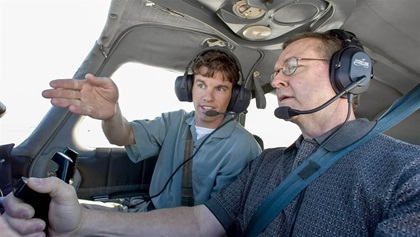
ASI News
Checkrides demystified
Tips for success from ASI’s flight instructors
By Alicia Herron
After hours of training, hard work, and thousands of dollars, it’ll soon be time for the final test: the checkride! Like much of flight training, the checkride is a new experience, and stress of the unknown can make the day more challenging than it needs to be. Here are some insights from the AOPA Air Safety Institute’s flight instructors to help you succeed.
Make sure you get a good night’s rest before the checkride. Don’t stay up studying or cramming; try to relax. Eat normally even if you’re nervous and don’t feel hungry, and pack some of your favorite energizing snacks and water in your flight bag.
Before showing up to the checkride, ensure you have all the required documentation (such as logbooks, endorsements, and Airman Knowledge Test Report) with you. Don’t forget to bring necessary equipment (plotter, flight computer, view limiting device) and make sure you know how to use it. If you’re relying on an electronic device, bring the charger as well.
The checkride consists of two main parts—the oral exam and the flight test. During the oral portion, the designated pilot examiner (DPE) will ask questions to assess your knowledge. If you don’t understand a question, ask the examiner to rephrase or restate it. If you’re still unsure after that, don’t try to bluff your way through the answer, but offer to look it up (see “Checkride 101: In the Hot Seat,” p. 14).
Once you move on to the flight test, you’re halfway there. Don’t think of the DPE as an instructor—you are the PIC during the checkride. In flight, remember the three Ds: Don’t do anything Dumb, Different, or Dangerous. The examiner is a resource for you to use, and it might be helpful to think of them as your first passenger. They will help scan for traffic and may even hold charts and nav logs (or your electronic flight bag) for you.
Silence from the examiner is normal, and you are under no obligation to fill the void. The examiner is required to notify you upon failure of an airman certification standards item, and if you bust, you bust immediately. As long as the ride is continuing, you’re passing, so even if you perform a less-than-perfect maneuver, don’t give up. If you do make a mistake, say why you made it, and then apply corrective action. It will demonstrate your ability to quickly identify and correct errors, even your own.
Finally, remember that the examiner really wants you to succeed but is obligated to ensure you are a safe pilot and can perform according to the FAA’s standards. If you are not able to do that, it doesn’t mean you’re a bad pilot; it just means you need a little more work to hit that mark. Review any problem areas with your CFI and you should be successful on your retest.
Earning your certificate is an invitation to continue to train, not a reason to stop. After you pass, stay in touch with your CFI and plan to fly with them occasionally, and at least once a year. The sky will be yours to explore, and the more you fly, the better, safer, and more proficient you’ll be.
Industry News
AOPA 'disappointed' in ruling
Court upholds FAA order in warbird flight training case
By Dan Namowitz
 A federal court declined to lift a cease-and-desist order issued by the FAA against a warbird flight training company in a case that could have implications for a wide variety of flight instruction provided to owners in their own aircraft. AOPA and five other aviation organizations had filed a “friend of the court” (amicus curiae) brief in the case, Warbird Adventures, Inc. et al. v. FAA, in which the FAA alleged that the company was operating a limited category aircraft, a Curtiss P–40N Warhawk, for compensated flight training without a required exemption. The court denied a petition by Warbird Adventures and its owner for review of the FAA’s cease-and-desist order. The P–40N “is not certified for paid flight instruction and substantial evidence supports the order,” the court said in a two-page judgment.
A federal court declined to lift a cease-and-desist order issued by the FAA against a warbird flight training company in a case that could have implications for a wide variety of flight instruction provided to owners in their own aircraft. AOPA and five other aviation organizations had filed a “friend of the court” (amicus curiae) brief in the case, Warbird Adventures, Inc. et al. v. FAA, in which the FAA alleged that the company was operating a limited category aircraft, a Curtiss P–40N Warhawk, for compensated flight training without a required exemption. The court denied a petition by Warbird Adventures and its owner for review of the FAA’s cease-and-desist order. The P–40N “is not certified for paid flight instruction and substantial evidence supports the order,” the court said in a two-page judgment.
“AOPA is disappointed by this decision and its finding that when a flight student is paying for instruction, the student is being carried for compensation. This departs from the long-standing premise that the compensation a flight instructor receives for instruction is not compensation for piloting the aircraft, but rather is compensation for the instruction,” said Justine Harrison, AOPA’s general counsel.
Implications of rulings in the case could be far-reaching for flight instruction. Although the decision is “unpublished,” meaning the court saw no precedential value in it, the decision may still be cited in future cases that could then set precedent binding on FAA proceedings held before judges of the NTSB, the Department of Transportation, and federal district courts.
Answering your questions
By Justine Harrison, AOPA General counsel
Many AOPA members have been reaching out to us about the recent court decision to allow an FAA emergency cease-and-desist order to stand against Warbird Adventures. The decision leaves many questions and concerns in its wake. It’s useful to analyze the decision from two perspectives: immediate impacts, and potential future impacts.
First, it’s important to know that the Warbird Adventures case started when the U.S. Court of Appeals for the District of Columbia Circuit was asked to review an FAA emergency cease-and-desist order received by the operator of a limited category aircraft, which was providing flight instruction without an exemption to FAR 91.315. A limited category aircraft is an aircraft not designed to meet current FAA certification requirements; many warbirds fall into this category. The court’s decision declining to review the emergency cease-and-desist order is just two pages.
Here are the most common questions we have heard and AOPA’s current perspective.
How does the decision immediately impact general aviation?
If you provide instruction for compensation in a limited category aircraft, regardless of who owns the aircraft, you need an exemption from FAR 91.315 to do so. The court’s decision does not differentiate between whether the student owns the airplane or not, so until the FAA officially says otherwise, all training in limited category aircraft requires an exemption.
How will the decision impact GA in the future, particularly flight training?
It’s too soon to tell. AOPA and other associations were involved in this case early because of concerns about potential downstream impacts of such a decision. We filed a “friend of the court” (amicus curiae) brief in late 2020 cautioning the court to avoid using broad language in its decision. Unfortunately, the decision contains an analysis stating that a student paying for flight instruction is “being carried for compensation.”
While the case decision was focused on flight training in a limited category aircraft, this broader language used in the decision raises concerns involving flight instruction in general. AOPA and other associations have asked the FAA to clarify how it views the decision impacting (1) the characterization of flight instruction, (2) flight instruction in limited category aircraft, and (3) flight instruction in other categories of aircraft. AOPA is deeply engaged in the issues—at legal and policy levels—and will provide updates on developments as they occur.
Does the decision mean CFIs and flight schools need a Part 135 certificate to provide flight training?
The decision does not require a Part 135 certificate for flight training. Remember that FAR 119.1 specifically exempts “student instruction” and “training” from certificate requirements.
I’m a CFI—do I have to worry about facing similar legal action if I continue instructing?
Not unless you’re providing instruction in a limited category aircraft without an exemption to FAR 91.315. The Warbird Adventures case revolved around how flight instruction can be legally provided in a limited category aircraft.
It’s also important to note that, before taking legal action against Warbird Adventures, the FAA repeatedly told the operator that it needed an exemption to provide flight instruction in the Curtiss P–40 Warhawk. The operator did not apply for an exemption, continued to use the P–40 for paid instruction, and continued to advertise paid instruction in the P–40 after receiving a letter from the FAA’s chief counsel. These were some of the reasons the court cited for declining to review the emergency order.
What’s next? Is there any sense of timing on when/if the FAA will clarify its interpretation of the ruling?
The FAA is working on clarifications for the flying public but has not specified when they will be released. We are in regular communication with the agency and will report any clarifications as soon as possible.
 The 2021 Flight Training Experience Survey opened May 15. The survey seeks out and recognizes flight training excellence. Anyone who has taken flight training—initial or recurrent—during the past 12 months can candidly assess the process and rate their individual experience through AOPA’s proven template for taking testimonials from consumers of aviation training services.
The 2021 Flight Training Experience Survey opened May 15. The survey seeks out and recognizes flight training excellence. Anyone who has taken flight training—initial or recurrent—during the past 12 months can candidly assess the process and rate their individual experience through AOPA’s proven template for taking testimonials from consumers of aviation training services.

